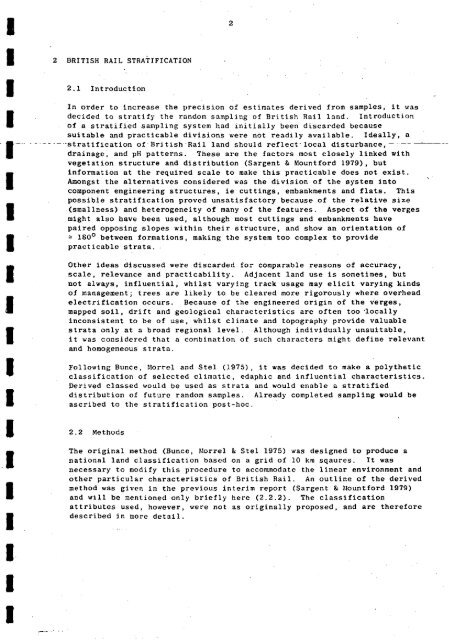Download (2674Kb) - NERC Open Research Archive - Natural ...
Download (2674Kb) - NERC Open Research Archive - Natural ...
Download (2674Kb) - NERC Open Research Archive - Natural ...
You also want an ePaper? Increase the reach of your titles
YUMPU automatically turns print PDFs into web optimized ePapers that Google loves.
2 BRITISH RAIL STRATIFICATION<br />
2.1 Introduction<br />
2<br />
In order to increase the precision of estimates derived from samples, it was<br />
decided to stratify the random sampling of British Rail land. Introduction<br />
of a stratified sampling system had initially been discarded because<br />
suitable and practicable divisions were not readily available. Ideally, a<br />
-- stratification of.British.Rail land should reflect'local disturbance, — --drainage,<br />
and pH patterns. These are the factors most closely linked with<br />
vegetation structure and distribution (Sargent & Mountford 1979), but<br />
information at the required scale to make this practicable does not exist.<br />
Amongst the alternatives considered was the division of the system into<br />
component engineering structures, ie cuttings, embankments and flats. This<br />
possible stratification proved unsatisfactory because of the relative size<br />
(smallness) and heterogeneity of many of the features. Aspect of the verges<br />
might also have been used, although most cuttings and embankments have<br />
paired opposing slopes within their structure, and show an orientation of<br />
= 1800 between formations, making the system too complex to provide<br />
practicable strata. .<br />
Other ideas discussed were discarded for comparable reasons of accuracy,<br />
scale, relevance and practicability. Adjacent land use is sometimes, but<br />
not always, influential, whilst varying track usage may elicit varying kinds<br />
of management; trees are likely to be cleared more rigorously where overhead<br />
electrification occurs. Because of the engineered origin of the Verges,<br />
mapped soil, drift and geological characteristics are often too locally<br />
inconsistent to be of use, whilst climate and topography provide valuable<br />
strata only at a broad regional level. Although individually unsuitable,<br />
it was considered that a combination of such characters might define relevant<br />
and homogeneous strata.<br />
Following Bunce, Morrel and Stel (1975), it was decided to make a polythetic<br />
classification of selected climatic, edaphic and influential characteristics.<br />
Derived classed would be used as strata and would enable a stratified<br />
distribution of future random samples. Already completed sampling would be<br />
ascribed to the stratification post-hoc.<br />
2.2 Methods<br />
The original method (Bunce, Morrel & Stel 1975) was designed to produce a<br />
national land classification based on a grid of 10 km sqaures. It was<br />
necessary to modify this procedure to accommodate the linear environment and<br />
other particular characteristics of British Rail. An outline of the derived<br />
method was given in the previous interim report (Sargent & Mountford 1979)<br />
and will be mentioned only briefly here (2.2.2). The classification<br />
attributes used, however, were not as originally proposed, and are therefore<br />
described in more detail.

















